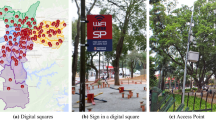Abstract
Before a dense Wi-Fi network is deployed, Wi-Fi providers must be careful with the performance promises they made in their way to win a bidding process. After such deployment takes place, Wi-Fi-network owners—such as public institutions—must verify that the QoS agreements are being fulfilled. We have merged both needs into a low-cost measurement system, a report of measurements at diverse scenarios and a performance prediction tool. The measurement system allows measuring the actual goodput that a set of users are receiving, and it has been used in a number of schools on a national scale. From this experience, we report measurements for different scenarios and diverse factors—which may result of interest to practitioners by themselves. Finally, we translate all the learned lessons to a freely-available capacity-planning tool for forecasting performance given a set of input parameters such as frequency, signal strength and number of users—and so, useful for estimating the cost of future deployments.






Similar content being viewed by others
References
Witzel, J. (2007). 802.11, it’s out there for free... if you know where to look. IEEE Instrumentation Measurement Magazine, 10(5), 54–57.
Henry, P. S., & Luo, H. (2002). WiFi: What’s next? IEEE Communications Magazine, 40(12), 66–72.
Yang, X., & Chen, B. (2018). A novel method for measurement points selection in access points localization. Wireless Networks, 24(1), 257–270.
Jardosh, A. P., Ramachandran, K. N., Almeroth, K. C., & Belding-Royer, E. M. (2005). Understanding congestion in IEEE 802.11b wireless networks. In ACM SIGCOMM conference on internet measurement (pp.25–25).
Angrisani, L., & Narduzzi, C. (2008). Testing communication and computer networks: An overview. IEEE Instrumentation Measurement Magazine, 11(5), 12–24.
Brik, V., Rayanchu, S., Saha, S., Sen, S., Shrivastava, V., & Banerjee, S. (2008). A measurement study of a commercial-grade urban WiFi mesh. In ACM SIGCOMM conference on internet measurement (pp. 111–124).
Raman, B., & Chebrolu, K. (2007). Experiences in using WiFi for rural Internet in India. IEEE Communications Magazine, 45(1), 104–110.
Kemerlis, V. P., Stefanis, E. C., Xylomenos, G., & Polyzos, G. C. (2006). Throughput unfairness in TCP over WiFi. In Conference on wireless on-demand network systems and services (pp. 26–31).
Koutsonikolas, D., & Hu, Y. C. (2011). On the feasibility of bandwidth estimation in wireless access networks. Wireless Networks, 17(6), 1561–1580.
Kandasamy, S., Morla, R., Ramos, P., & Ricardo, M. (2019). Predicting throughput in IEEE 802.11 based wireless networks using directional antenna. Wireless Networks, 25(4), 1567–1584.
Maity, M., Raman, B., & Vutukuru, M. (2017). TCP download performance in dense WiFi scenarios: Analysis and solution. IEEE Transactions on Mobile Computing, 16(1), 213–227.
Sangolli, S. V., & Jayavignesh, T. (2015). TCP throughput measurement and comparison of IEEE 802.11 legacy, IEEE 802.11n and IEEE 802.11ac standards. Indian Journal of Science and Technology, 8, 20.
Bianchi, G. (2000). Performance analysis of the IEEE 802.11 distributed coordination function. IEEE Journal on Selected Areas in Communications, 18(3), 535–547.
Dianu, M.-D., Riihijarvi, J., & Petrova, M. (2014). Measurement-based study of the performance of IEEE 802.11ac in an indoor environment. In IEEE international conference on communications (pp. 5771–5776).
Tirumala, A., Gates, M., Qin, F., Dugan, J., & Ferguson J. (2019). Iperf–the TCP/UDP bandwidth measurement tool. https://github.com/esnet/iperf.
DD-WRT. (2019). Opensource firmware for wlan routers and embedded systems. https://www.dd-wrt.com.
Kriara, L., Molero, E. C., & Gross, T. R. (2016). Evaluating 802.11ac features in indoor WLAN: An empirical study of performance and fairness. In ACM international workshop on wireless network testbeds, experimental evaluation, and characterization (pp. 17–24).
Simic, L., Riihijärvi, J., & Mähönen, P. (2017). Measurement study of IEEE 802.11ac Wi-Fi performance in high density indoor deployments: Are wider channels always better? In IEEE international symposium on a world of wireless, mobile and multimedia networks (pp. 1–9).
Liao, R., Bellalta, B., Barcelo, J., Valls, V., & Oliver, M. (2013). Performance analysis of IEEE 802.11ac wireless backhaul networks in saturated conditions. EURASIP Journal on Wireless Communications and Networking, 2013(1), 226.
Karmakar, R., Chattopadhyay, S., & Chakraborty, S. (2017). Impact of IEEE 802.11n/ac PHY/MAC high throughput enhancements on transport and application protocols–a survey. IEEE Communications Surveys Tutorials, 19(4), 2050–2091.
National Center for Education Statistics. (2019). Average class size in public primary schools, middle schools, high schools, and schools. https://nces.ed.gov/surveys/sass/tables/sass1112_2013314_t1s_007.asp.
Karmakar, R., Chattopadhyay, S., & Chakraborty, S. (2016). Channel access fairness in IEEE 802.11ac: A retrospective analysis and protocol enhancement. In ACM international symposium on mobility management and wireless access (pp. 51–58).
HPCN-UAM. WiFiLytics. (2019). https://github.com/jlgarciadorado/wifilytics.
Pokhrel, S. R., Panda, M., Vu, H. L., & Mandjes, M. (2016). TCP performance over WiFi: Joint impact of buffer and channel losses. IEEE Transactions on Mobile Computing, 15(5), 1279–1291.
Ixia. (2017). Ixia blackbook: 802.11ac Wi-Fi benchmarking. http://www.ixiacom.com/blackbook.
Candela Tech. (2019). Testing WiFi networks with LANforge. https://www.candelatech.com/lf_wifi.php.
Acknowledgements
This work was partially funded by the Spanish Ministry of Economy and Competitiveness and the European Regional Development Fund under the project TRÁFICA (MINECO/FEDER TEC2015-69417-C2-1-R) and by Naudit High Performance Computing and Networking under the project ESCUELAS CONECTADAS (Convenios 2018 y 2019 “Análisis de tráfico y supercomputación de sobremesa”, art. 83).
Author information
Authors and Affiliations
Corresponding author
Additional information
Publisher's Note
Springer Nature remains neutral with regard to jurisdictional claims in published maps and institutional affiliations.
Rights and permissions
About this article
Cite this article
García-Dorado, J.L., Ramos, J., Gomez-Arribas, F.J. et al. Instrumentation for measuring users’ goodputs in dense Wi-Fi deployments and capacity-planning rules. Wireless Netw 26, 2943–2955 (2020). https://doi.org/10.1007/s11276-019-02229-7
Published:
Issue Date:
DOI: https://doi.org/10.1007/s11276-019-02229-7




